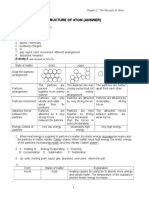Fitting Loss Calculation
Uploaded by
Svetla NikolovaFitting Loss Calculation
Uploaded by
Svetla NikolovaHPCBS
High Performance Commercial Building Systems
Commissioning Guide for Air Handling Systems
Calculation Of Energy Savings through Improved Fitting Design
Calculating Fitting Pressure loss for high velocity ducts
Assumptions:
V =4, 005 p velocity
Therefore:
2
pvelocity = V
4, 005
V = Velocity in feet per minute
4,005 = A units conversion constant
pvelocity = Velocity pressure in inches water column
( )
p fitting =C o p velocity
Where:
p fitting =Fitting pressure loss in inches water column
Co =Local loss coefficient
pvelocity =Velocity pressure in inches water column, usually ( but not always)
based on entering velocity
Flow rate =
Designer's target design friction rate =
20,000 cfm
0.10 inches w.c. per 100 ft. of duct
Duct height =
24 inches
Duct width =
60 inches
Velocity =
2,000 fpm
oss coefficient for a mitered elbow with no turning vanes =
1.03 (from ASHRAE Handbook, fitting CR3-6)
Loss coefficient for a mitered elbow with turning vanes =
0.11 (From ASHRAE Handbook, fitting CR3-9)
Calculation:
Velocity pressure =
0.25 in.w.c.
Loss for the elbow with no turning vanes =
0.26 in.w.c.
Loss for the elbow with turning vanes =
0.03 in.w.c.
Difference (avoided pressure drop if vanes are installed) =
0.23 in.w.c.
File name = 271666934.xls, Page 1 of 6 of Sheet High Velocity loss Printed on 05/27/2015 at 15:37:00
Calculations are subject to user assumptions and inputs. PIER, LBNL, and PECI assume no responsibility for their application.
HPCBS
High Performance Commercial Building Systems
Functional Testing Guide for Air Handling Systems
Appendix D.2.5 Example 3 - Savings Associated with an Improved Duct Fitting Design at a Riser Connection
Assumptions:
QNew
QOld
( )
PNew = POld
Where:
PNew =The static pressure at the new flow condition to be evaluated .
POld = The static pressure at the old or original flow condition, usually the design condition.
Q New = The flow at the new flow condition to be evaluated .
Q Old = The flow at the old or original flow condition, usually the design condition.
Horsepower=
QPSaved
6, 356 FanStaticMotor
Where:
Horsepower=The horsepower saved at the terminals of the motor ( includes motor efficiency losses)
Q= The flow rate which is experiencing the reduction in static pressure in cubic feet per minute (cfm)
PSaved = The static pressure reduction associated with the improvement in inches water column (in . w. c .)
6, 356= A units conversion constant
FanStatic = The fan static efficiency
Motor= The motor efficiency
Savings associated with having the turning vanes =
System flow rate =
0.23 inches w.c.
20,000 cfm
Calculation:
Horsepower savings to be used for the energy calculation based on the reduced flow rate
Flow rate =
Static pressure reduction =
Assumed fan efficiency =
Assumed motor efficiency =
20,000 cfm
0.23 in.w.c.
75% (estimated)
89% (from energy efficient motor performance data in file)
Fan horse power reduction =
1.09 hp.
kW =
0.81 kW
File name = 271666934.xls,
Calculations are subject to the assumptions and inputs. PIER, LBNL, and PECI assume no responsibility thier application and use.
HPCBS
High PerformanceCommercial Building Systems
Functional Testing Guide for Air Handling
Systems
Appendix D.2.5 Example 3 - Savings Associated with an Improved Duct Fitting Design at a Riser Connection
Assumptions:
Constant volume system operation
Current system operating hours =
Operating hours after the first year =
Current electrical rate =
kW savings per hour at design flow =
2,860 hr/yr (5 days at 10 hr./day and 1 day at 5 hr./day, 52 wk/yr)
8,760 hr/yr
$0.0900 $/kWh
0.81 per hour (from previous calculation)
Calculation:
Annual savings at current operating schedule =
=
Annual savings at future operating schedule =
=
2,321 kWh
$209 per year
7,108 kWh
$640 per year
File name = 271666934.xls,
Calculations are subject to the assumptions and inputs. PIER, LBNL, and PECI assume no responsibility thier application and use.
HPCBS
High PerformanceCommercial Building Systems
Functional Testing Guide for Air Handling Systems
Appendix D.2.5 Example 3 - Savings Associated with an Improved Duct Fitting Design at a Riser Connection
Assumptions:
V =4, 005 p velocity
Therefore:
2
V
pvelocity =
4, 005
V = Velocity in feet per minute
4,005 = A units conversion constant
pvelocity = Velocity pressure in inches water column
( )
p fitting =C o p velocity
Where:
p fitting =Fitting pressure loss in inches water column
Co =Local loss coefficient
pvelocity =Velocity pressure in inches water column, usually ( but not always)
based on entering velocity
Flow rate =
Designer's target design friction rate =
350 cfm
0.10 inches w.c. per 100 ft. of duct
Duct height =
6 inches
Duct width =
12 inches
Velocity =
700 fpm
oss coefficient for a mitered elbow with no turning vanes =
1.03 (from ASHRAE Handbook, fitting CR3-6)
Loss coefficient for a mitered elbow with turning vanes =
0.11 (From ASHRAE Handbook, fitting CR3-9)
Calculation:
Velocity pressure =
0.031 in.w.c.
Loss for the elbow with no turning vanes =
0.031 in.w.c.
Loss for the elbow with turning vanes =
0.003 in.w.c.
Difference (avoided pressure drop if vanes are installed) =
0.028 in.w.c.
File name = 271666934.xls,
Calculations are subject to the assumptions and inputs. PIER, LBNL, and PECI assume no responsibility thier application and use.
HPCBS
High PerformanceCommercial Building Systems
Functional Testing Guide for Air Handling Systems
Appendix D.2.5 Example 3 - Savings Associated with an Improved Duct Fitting Design at a Riser Connection
Assumptions:
Q New
Q Old
( )
PNew = POld
Where:
PNew =The static pressure at the new flow condition to be evaluated .
POld = The static pressure at the old or original flow condition, usually the design condition.
QNew = The flow at the new flow condition to be evaluated .
QOld = The flow at the old or original flow condition, usually the design condition.
Horsepower=
QPSaved
6, 356 FanStatic Motor
Where:
Horsepower=The horsepower saved at the terminals of the motor ( includes motor efficiency losses)
Q= The flow rate which is experiencing the reduction in static pressure in cubic feet per minute (cfm)
PSaved = The static pressure reduction associated with the improvement in inches water column (in . w. c .)
6, 356= A units conversion constant
FanStatic = The fan static efficiency
Motor = The motor efficiency
Savings associated with having the turning vanes =
System flow rate =
0.028 inches w.c.
350 cfm
Calculation:
Horsepower savings to be used for the energy calculation based on the reduced flow rate
Flow rate =
Static pressure reduction =
Assumed fan efficiency =
Assumed motor efficiency =
350 cfm
0.028 in.w.c.
75% (estimated)
89% (from energy efficient motor performance data in file)
Fan horse power reduction =
0.002 hp.
kW =
0.002 kW
File name = 271666934.xls,
Calculations are subject to the assumptions and inputs. PIER, LBNL, and PECI assume no responsibility thier application and use.
HPCBS
High PerformanceCommercial Building Systems
Functional Testing Guide for Air Handling
Systems
Appendix D.2.5 Example 3 - Savings Associated with an Improved Duct Fitting Design at a Riser Connection
Assumptions:
Constant volume system operation
Current system operating hours =
Operating hours after the first year =
Current electrical rate =
kW savings per hour at design flow =
2,860 hr/yr (5 days at 10 hr./day and 1 day at 5 hr./day, 52 wk/yr)
8,760 hr/yr
$0.0900 $/kWh
0.002 per hour (from previous calculation)
Calculation:
Annual savings at current operating schedule =
=
Annual savings at future operating schedule =
=
5 kWh
$0.45 per year
15 kWh
$1.37 per year
File name = 271666934.xls,
Calculations are subject to the assumptions and inputs. PIER, LBNL, and PECI assume no responsibility thier application and use.
You might also like
- 2019-06 Marriott Hotel Design Standards - HVAC100% (10)2019-06 Marriott Hotel Design Standards - HVAC39 pages
- 2019-06 Marriott Hotel Design Standards Managed - FireNo ratings yet2019-06 Marriott Hotel Design Standards Managed - Fire5 pages
- BCA Energy Performance Points CalculatorNo ratings yetBCA Energy Performance Points Calculator96 pages
- GAPS Guidelines: Ventilation of Fire Pump RoomsNo ratings yetGAPS Guidelines: Ventilation of Fire Pump Rooms3 pages
- Circuit Setter Valve Balance Procedure: Technical ManualNo ratings yetCircuit Setter Valve Balance Procedure: Technical Manual36 pages
- Design Calculation Sheet: A-Water DemandNo ratings yetDesign Calculation Sheet: A-Water Demand1 page
- HVAC Design For Pharmaceutical Facilities R1No ratings yetHVAC Design For Pharmaceutical Facilities R157 pages
- AHU FAN EXTERNAL STATIC PRESSURE CALCULATION METHODNo ratings yetAHU FAN EXTERNAL STATIC PRESSURE CALCULATION METHOD5 pages
- Minimum Smoke-Layer Depth in Atrium Smoke ControlNo ratings yetMinimum Smoke-Layer Depth in Atrium Smoke Control11 pages
- Piping Layout For Fire Sprinkler System: An Overview: Kshitiz VishnoiNo ratings yetPiping Layout For Fire Sprinkler System: An Overview: Kshitiz Vishnoi5 pages
- Water Pressure Loss Calculator Colebrook WhiteNo ratings yetWater Pressure Loss Calculator Colebrook White5 pages
- Static Pressure For AHU's and Fans - 21.01.2013No ratings yetStatic Pressure For AHU's and Fans - 21.01.201312 pages
- Polaris Booster Pump Installation InstructionsNo ratings yetPolaris Booster Pump Installation Instructions4 pages
- TIGERFLOW Booster Sizing Worksheet: I. Pressure Required100% (1)TIGERFLOW Booster Sizing Worksheet: I. Pressure Required3 pages
- Domestic Water Pipe Sizing Ib P Pc2014 009No ratings yetDomestic Water Pipe Sizing Ib P Pc2014 00920 pages
- Caleffi: Discal Magnetic Air and Dirt SeparatorNo ratings yetCaleffi: Discal Magnetic Air and Dirt Separator8 pages
- 30RQM/30RQP 160-520: Air-to-Water Scroll Heat Pump With Greenspeed IntelligenceNo ratings yet30RQM/30RQP 160-520: Air-to-Water Scroll Heat Pump With Greenspeed Intelligence26 pages
- Installation Manual: Air To Water Heat PumpNo ratings yetInstallation Manual: Air To Water Heat Pump94 pages
- Energy Efficient Solutions: For Commercial Kitchen VentilationNo ratings yetEnergy Efficient Solutions: For Commercial Kitchen Ventilation8 pages
- Estimating Daily Domestic Hot-Water Use in North American HomesNo ratings yetEstimating Daily Domestic Hot-Water Use in North American Homes15 pages
- ASHRAE 188 Standard The Impact On Domestic Hot Water System DesignNo ratings yetASHRAE 188 Standard The Impact On Domestic Hot Water System Design24 pages
- Simulating Domestic Hot Water Demand by Means of A Stochastic End-Use ModelNo ratings yetSimulating Domestic Hot Water Demand by Means of A Stochastic End-Use Model172 pages
- Industrial Floor Framing For Vibrating Equipment: Ernest L. Klaber, P.ENo ratings yetIndustrial Floor Framing For Vibrating Equipment: Ernest L. Klaber, P.E44 pages
- Download Complete Chemical Ionization Mass Spectrometry Second Edition Alex G. Harrison PDF for All Chapters100% (2)Download Complete Chemical Ionization Mass Spectrometry Second Edition Alex G. Harrison PDF for All Chapters62 pages
- Full download Viscous Fluid Flow 4th Edition Frank M. White pdf docx100% (2)Full download Viscous Fluid Flow 4th Edition Frank M. White pdf docx41 pages
- Model 800 Viscometer Instruction ManualNo ratings yetModel 800 Viscometer Instruction Manual24 pages
- Chbe 251 - Transport Phenomena I Tutorial IiiNo ratings yetChbe 251 - Transport Phenomena I Tutorial Iii17 pages
- Transformer Oil Filtering, Degassing and Drying Unit100% (2)Transformer Oil Filtering, Degassing and Drying Unit16 pages
- Directions: Read and Answer The Questions Below. Encircle The Letter of The Correct AnswerNo ratings yetDirections: Read and Answer The Questions Below. Encircle The Letter of The Correct Answer3 pages
- Kami Export - Newton Laws Stephen Murray WK SheetNo ratings yetKami Export - Newton Laws Stephen Murray WK Sheet2 pages
- 2019-06 Marriott Hotel Design Standards Managed - Fire2019-06 Marriott Hotel Design Standards Managed - Fire
- Circuit Setter Valve Balance Procedure: Technical ManualCircuit Setter Valve Balance Procedure: Technical Manual
- AHU FAN EXTERNAL STATIC PRESSURE CALCULATION METHODAHU FAN EXTERNAL STATIC PRESSURE CALCULATION METHOD
- Piping Layout For Fire Sprinkler System: An Overview: Kshitiz VishnoiPiping Layout For Fire Sprinkler System: An Overview: Kshitiz Vishnoi
- TIGERFLOW Booster Sizing Worksheet: I. Pressure RequiredTIGERFLOW Booster Sizing Worksheet: I. Pressure Required
- 30RQM/30RQP 160-520: Air-to-Water Scroll Heat Pump With Greenspeed Intelligence30RQM/30RQP 160-520: Air-to-Water Scroll Heat Pump With Greenspeed Intelligence
- Energy Efficient Solutions: For Commercial Kitchen VentilationEnergy Efficient Solutions: For Commercial Kitchen Ventilation
- Estimating Daily Domestic Hot-Water Use in North American HomesEstimating Daily Domestic Hot-Water Use in North American Homes
- ASHRAE 188 Standard The Impact On Domestic Hot Water System DesignASHRAE 188 Standard The Impact On Domestic Hot Water System Design
- Simulating Domestic Hot Water Demand by Means of A Stochastic End-Use ModelSimulating Domestic Hot Water Demand by Means of A Stochastic End-Use Model
- Industrial Floor Framing For Vibrating Equipment: Ernest L. Klaber, P.EIndustrial Floor Framing For Vibrating Equipment: Ernest L. Klaber, P.E
- Download Complete Chemical Ionization Mass Spectrometry Second Edition Alex G. Harrison PDF for All ChaptersDownload Complete Chemical Ionization Mass Spectrometry Second Edition Alex G. Harrison PDF for All Chapters
- Full download Viscous Fluid Flow 4th Edition Frank M. White pdf docxFull download Viscous Fluid Flow 4th Edition Frank M. White pdf docx
- Transformer Oil Filtering, Degassing and Drying UnitTransformer Oil Filtering, Degassing and Drying Unit
- Directions: Read and Answer The Questions Below. Encircle The Letter of The Correct AnswerDirections: Read and Answer The Questions Below. Encircle The Letter of The Correct Answer











































































































